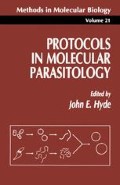Abstract
The polymerase chain reaction (PCR) allows the specific amplifica tion of either RNA or DNA nucleotide sequences (1,2). The hallmarks of this technique are specificity, sensitivity, and speed. The specific ity of the reaction is a result of the requirement of DNA polymerases for a primer that is extended only when annealed to its complemen tary sequence. The primers in the PCR are synthetic oligonucleotides designed to be complementary to the intended target sequence. The sensitivity of PCR is shown by the ability to amplify a target sequence from a single cell under appropriate conditions (3). Finally, PCR analy sis is normally rapid; a typical 30 cycle reaction is complete in about 3 h. In addition, the introduction of a thermostable DNA polymerase isolated from Thermus aquaticus (Taq) has allowed the reaction to be automated, greatly increasing the number of samples that can be con veniently processed at once.
Access this chapter
Tax calculation will be finalised at checkout
Purchases are for personal use only
References
Mullis, K., Faloona, F, Scharf, S., Saiki, R., Horn, G., and Erlich, H. (1986) Specific amplification of DNA in vitro: the polymerase chain reaction. Cold Spring Harbor Symp. Quant. Biol. 51, 263–273.
Mullis, K. B. and Faloona, F. A., (1987) Specific synthesis of DNA in vitro via a polymerase-catalyzed chain reaction. Methods Enzymol. 155, 335–350
Li, H. H., Gyllensten, U. B., Cui, X. F., Saiki, R. K., Erlich, H. A, and Arnheim, N. (1988) Amplification and analysis of DNA sequences in single human sperm and diploid cells. Nature 335, 414–417.
Wright, P. A. and Wynford-Thomas, D. (1990) The polymerase chain reac tion Miracle or Mirage? A critical review of its uses and limitations in diag nosis and research J. Pathol. 162, 99–117.
Bruce-Chwatt, L. J., Black, R. H., Canfield, C J., Clyde, D. F., Peters, W., and Wernsdorfer, W. H. (1986) Chemotherapy of malaria. World Health Organi zation, Geneva, Switzerland
Peterson, D. S., Walliker, D, and Wellems, T. E. (1988) Evidence that a point mutation in dihydrofolate reductase-thymidylate synthase confers resistance to pyrimethamine in falciparum malaria. Proc Natl. Acad Sci. USA 85,9114–9118
Cowman, A. F, Morry, M. J., Biggs, B. A., Cross, G. A., and Foote, S. J. (1988) Amino acid changes linked to pyrimethamine resistance in the dihydro folate reductase-thymidylate synthase gene of Plasmodium falciparum. Proc. Natl. Acad Sci. USA 85, 9109–9113.
Zolg, J, W, Plitt, J R., Chen, G. X., and Palmer, S (1989) Point mutations in the dihydrofolate reductase-thymidylate synthase gene as the molecular basis for pyrimethamine resistance in Plasmodium falciparum Mol. Biochem Parasitol. 36, 253–262
Snewin, V A., England, S. M, Sims, P F G., and Hyde, J E. (1989) Charac terization of the dihydrofolate reductase-thymidylate synthetase gene from human malaria parasites highly resistant to pyrimethamine. Gene 76, 41–52.
Zolg, J.W, Chen, G X., and Plitt, J. R. (1990) Detection of pyrimethamine resistance in Plasmodium falciparum by mutation-specific polymerase chain reaction Mol. Biochem. Parasitol. 39,257–265.
Peterson, D. S., Di Santi, S. M., Povoa, M., Calvosa, V. S., Do Rosario, V. E, and Wellems, T. E. (1991) High incidence of Asn-108 mutations in dihydro folate reductase as the basis for pyrimethamine resistant falciparum malaria in the Brazilian Amazon. Am J. Trop. Med. Hyg. 45, 492–497.
Wu, D. Y., Ugozzoli, L., Pal, B. K., and Wallace, R B. (1989) Allele-specific enzymatic amplification of beta-globin genomic DNA for diagnosis of sickle cell anemia Proc. Natl Acad. Sci. USA 86, 2757–2760.
Newton, C. R., Graham, A., Heptinstall, L. E., Powell, S. J., Summers, C, Kalsheker, N., Smith, J. C, and Markham, A. F. (1989) Analysis of any point mutation in DNA The amplification refractory mutation system (ARMS). Nucl. Acids Res 17, 2503–2516
Ehlen, T. and Dubeau, L. (1989) Detection of ras point mutations by poly merase chain reaction using mutation-specific, inosine-containing oligonucle otide primers. Biochem. Biophys. Res. Commun 160, 441–447.
Kwok, S., Kellogg, D. E., McKinney, N., Spasic, D., Goda, L., Levenson, C, and Sninsky, J. J. (1990) Effects of primer-template mismatches on the poly merase chain reaction: human immunodeficiency virus type 1 model studies. Nucl. Acids Res 18, 999–1005.
Okayama, H., Curiel, D. T., Brantly, M. L., Holmes, M. D., and Crystal, R. G (1989) Rapid, nonradioactive detection of mutations in the human genome by allele-specific amplification. J. Lab. Clin. Med. 114, 105–113.
Roos, M. H. (1990) The molecular nature of benzimidazole resistance in hel minths. Parasitol Today 6,125–127
Driscoll, M, Dean, E., Reilly, E, Bergholz, E., and Chalfie, M. (1989) Genetic and Molecular Analysis of a Caenorhabditis elegans β-tubulin that conveys benzimidazole sensitivity. J Cell Biol. 109, 2992–3003
Brindley, P. J, Heath, S., Waters, A. P., McCutchan, T F., and Sher, A. (1991) Characterization of a programmed alteration on an 18S ribosomal gene that accompanies the experimental induction of drug resistance in Schistosoma mansoni. Proc Natl. Acad. Sci. USA 88, 7754–7758
Sambrook, J, Fritsch, E F, and Maniatis, T. (1989) Molecular Cloning. A Laboratory Manual. Cold Spring Harbor Laboratory, Cold Spring Harbor, NY
Sommer, R. and Tautz, D. (1989) Minimal homology requirements for PCR primers Nucl Acids Res. 17, 6749.
Author information
Authors and Affiliations
Editor information
Editors and Affiliations
Rights and permissions
Copyright information
© 1993 Humana Press Inc, Totowa, NJ
About this protocol
Cite this protocol
Peterson, D.S. (1993). PCR Methods for Identification of Point Mutations and Gene Rearrangements. In: Hyde, J.E. (eds) Protocols in Molecular Parasitology. Methods in Molecular Biology™, vol 21. Humana Press. https://doi.org/10.1385/0-89603-239-6:213
Download citation
DOI: https://doi.org/10.1385/0-89603-239-6:213
Publisher Name: Humana Press
Print ISBN: 978-0-89603-239-2
Online ISBN: 978-1-59259-508-2
eBook Packages: Springer Protocols

